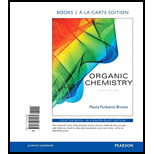
(a)
Interpretation:
The structure of the given compound (E)-Hydrazone of Benzaldehyde has to be drawn.
Concept introduction:
Imines can exists as stereoisomers. The isomers are named using the E, Z system of nomenclature. The lone pair has the low priority.
If the two high priority groups are on the same side of the double bond, then it is known as Z-isomer.
If the two high priority groups are on the opposite side of the double bond then it is known as E-isomer.
(b)
Interpretation:
The structure of the given compound (Z)-oxime of propiophenone has to be drawn.
Concept introduction:
Imines can exist as stereoisomers. The isomers are named using the E, Z system of nomenclature. The lone pair has the low priority.
If the two high priority groups are on the same side of the double bond, then it is known as Z-isomer.
If the two high priority groups are on the opposite side of the double bond then it is known as E-isomer.
Trending nowThis is a popular solution!

Chapter 16 Solutions
Organic Chemistry, Books a la Carte Edition (8th Edition)
- Draw the structure of each of the following compounds:a. the (E)-hydrazone of benzaldehyde b. the (Z)-oxime of propiophenonearrow_forwarda. What two amides are obtained from the reaction of acetyl chloride with an equivalent of ethylamine and an equivalent of propylamine?b. Why is only one amide obtained from the reaction of acetyl chloride with an equivalent of ethylamine and an equivalent of triethylamine?arrow_forwardWhich could explain the stronger acidity of phenols compared to alcohols. Why? a.pi-electron delocalization b.steric effect c.hydrogen bonding d.hyperconjugationarrow_forward
- What will be the final product when 1-butanol is oxidized with Cro, in an acidic medium? Select one: A. butanoic acid B. butanal C. butyl chromate D. butyl butanoatearrow_forwardWhat compounds are formed from the reaction of benzoyl chloride with the following reagents? a. sodium acetate b. water c. excess dimethylamine d. aqueous HCl e. aqueous NaOH f. cyclohexanol g. excess benzylamine h. 4-chlorophenol i. isopropyl alcohol j. excess aniline k. potassium formatearrow_forwardWhy are epoxides more reactive than other ethers (open chain and larger cyclic ethers)? Select one: A. It is easier for epoxides to undergo loss of water compared to other ethers. B. Epoxides are stronger bases than other ethers. C. Their reactions, a ring-opening process, relieves the strain of a three-membered ring D. Epoxides are more easily oxidized than other ethers.arrow_forward
- When an equimolar mixture of 1-butanamine and 1-bromobutane reacts, which of these products will form? Select one: a. Tetrabutylammonium bromide b. Dibutylamine c. All of these d. Tributylaminearrow_forwardIn the reaction of a nitrile with a Grignard reagent, there are two steps: a) nucleophilic addition of the Grignard to form an imine ion and b) hydrolysis of the imine to form a ketone. Draw the intermediate and the final product in this reaction. Ignore inorganic byproducts. 1. CH₂MgBr 2. H3O* Draw Imine Ion Intermediate 1. H30¹ 2. Neutralizing work-up aarrow_forwardWrite reactions of aniline with the following reagents: a. CH3COCl b. Br2 c. CH3Iarrow_forward
- 1. What are the possible interferences or complications in detecting and differentiating aldehydesand ketones using the following tests:a. 2,4-dinitrophenyl hydrazine test b. benedicts test c. tollens test d. jones test e. iodoform test 2. Describe the positive results for the following qualitative tests:a. 2,4-dinitrophenyl hydrazine testarrow_forwardWhat compound results when 2-pentanol is treated with HCl and ZnCl2? A. CH3CH2CH2CH2CH2CL B. CH3CH(Cl)CH2CH2CH3 C. CH3CH2CH2CH2CH2ZnCl D. CH3CH2CH2Ch2CO2Clarrow_forwardWhat test will allow you to distinguish between: a. benzyl alcohol and cyclohexanolb. benzyl alcohol and phenol c. cyclohexanol and 1-methylcyclohexanol d. o-cresol and anisolee. benzyl alcohol and anisolearrow_forward
 Organic Chemistry: A Guided InquiryChemistryISBN:9780618974122Author:Andrei StraumanisPublisher:Cengage Learning
Organic Chemistry: A Guided InquiryChemistryISBN:9780618974122Author:Andrei StraumanisPublisher:Cengage Learning

